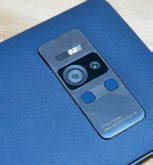ASUS ZenFone AR.


ASUS ZenFone AR.

CONCLUSION
Barely two months after the ZenFone Zoom S comes ASUS’ latest experiment – the ZenFone AR (ZS571KL). This is the second smartphone to support Google Tango’s augmented reality engine (the first being Lenovo’s Phab 2 Pro). However, the ZenFone AR is one of the first to support both Tango, and Google’s virtual reality platform, Daydream VR.
If you’re used to midrange smartphones, the ZenFone AR’s choice of bezels, glass display, and button placements shouldn’t come as a surprise, though it keeps the 3.5mm headphone jack intact. It also has an aluminum alloy frame, and it features a sandblasted finish with chamfered edges.
Aesthetically, the ZenFone AR’s rear doesn’t do the phone justice. We didn’t mind the outdated burnished faux leather look (fashion is cyclical, after all) but the average consumer deserves better than a plastic imitation when they are paying nearly $1,200 for a device. A polished glass rear or aluminum back would likely be more attractive, and definitely less patronizing to both fans and converts.
The display is a 5.7-inch, Quad HD (2,560 x 1,440 pixels resolution) Super AMOLED with a 79% screen-to-body ratio. It’s made of Gorilla Glass 4. Common properties and expectations of AMOLED screens include its warmer color temperature. This characteristic lends its vibrant appearance, which may be a preferred experience for some users.
The ASUS ZenFone AR runs on Android 7.0 OS (Nougat) with its very own skin, ZenUI 3.0. ASUS did away with the juvenile outlook by opting for single-hue palettes instead of the gradients it once loved. Their notifications dropdown and settings also have a cleaner look.
The namesake of this device stems from its inclusion of Google Tango, which makes augmented reality apps functional on a smartphone. Tango requires a combination of sensors and Google’s software, and it allows a smartphone to understand human concepts like threedimensional physical space, relative distance, and depthperception.
By far, the most useful feature that also demonstrated Tango’s capabilities was Measure (a Google made app), and it was limited to the phone camera’s depth-sensing capabilities. The other pre-installed AR apps don’t exploit the precision offered by Google Tango, and neither do they add value like the example provided above. It’s a mixed bag of half-baked content, bloatware, and blatant advertising.
Then there’s Google Daydream. Like Tango, Daydream’s practicality is limited to the apps that are available in the store, but it was nowhere as desolate as AR. The Daydream View headset and controller are quite intuitive for most Google VR apps because of the view-centering feature that also re-calibrates your controller with ease. Games work best with the VR ecosystem, and it’s the only genre that works well at the moment. Sadly, the Daydream View headset and remote aren’t officially sold by Google in Singapore.
The rear camera is a 23-megapixel Sony Exmor RS IMX318 sensor. It’s supported by a six-element lens with an aperture of f/2.0, 4-axis Optical Image Stabilization, and TriTech Autofocus – a combination of laser, phase detection, and contrast detection autofocus that debuted on the ZenFone 3. Image quality seems to be on par with what the ZenFone 3 Deluxe offered. Good points are its color control, and its general attention to detail within the focused area. It’s acceptable, but still below expectations, as it hasn’t really improved from the cheaper ZenFone 3 Deluxe, which we already weren’t all that impressed with.

AT A GLANCE
DISPLAY 5.7-inch / 2,560 x 1,440 pixels / Super AMOLED.
PROCESSOR Qualcomm Snapdragon 821.
REAR CAMERA 23-megapixel, f/2.0, laser, TriTech autofocus.
DIMENSIONS 158.7 x 77.4 x 4.6 - 8.9mm.
PRICE $1,198.


The ASUS ZenFone AR has an average battery uptime for daily tasks, and it’s sufficient at performing its intended AR purposes. If we’re looking strictly within the ZenFone range, this is certainly ASUS’s most powerful phone to date, even if it has subpar imaging performance for its class.
Moderate phone capabilities aside, phone prices are definitely on the rise and that begets certain baseline expectations. Certainly, it is expected you’d pay more for Tango features as it does require dedicated hardware and sensors, but there’s the Lenovo Phab 2 Pro that can offer that for $300 less. You also won’t be paying for a current flagship processor any more. So, again, ASUS brought in a promisingon- paper product too late to the game. The ZenFone AR didn’t fix our bugbears from the ZenFone 3 Deluxe, and it’s just no longer a competitive option in the current smartphone climate for price, performance or features, even after taking Tango and Daydream into consideration.

PICTURES ASUS























